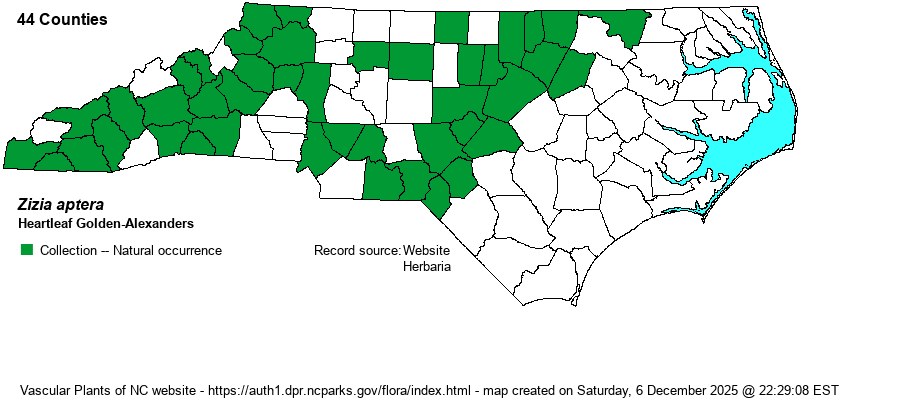| Author | (A. Gray) Fernald | |
| Distribution | Present throughout the Mountains and the Piedmont, but of spotty occurrence in the latter province. Barely ranges east into the edge of the Coastal Plain.
This is a wide-ranging species, from coast to coast. It occurs from NY and WA south to western FL and NV. | |
| Abundance | Frequent in the Mountains, but mostly infrequent in the Piedmont. Very rare in the western edge of the Coastal Plain. | |
| Habitat | This is a species of wooded openings, wooded margins, roadbanks, and other partly shaded places. It prefers moist or rich soil than dry soil. | |
| Phenology | Blooms in April and May, and fruits in July and August. | |
| Identification | This is a sparingly branched herb growing to about 2 feet tall. It looks nothing like the other two Zizia species, but closely resembles Thaspium trifoliatum, so care must be taken to separate these two. Both species have a simple basal leaf, cordate to orbicular, about 1.5-2 inches across with a serrated margin, and a long petiole of 2-3 inches, at least. Each has stem leaves that are alternate but only once-divided into 3 leaflets, with the leaflets of variable shape (ovate to rounded), 1-2 inches long and somewhat narrower. Each has yellow and flat-topped umbels, as well. In this species, the teeth on the leaflets are rather acute as opposed to obtuse (blunter) in the Thaspium; the leaflet margins are often ciliate (use a hand lens), but both have a hyaline (thin and colorless) margin; the lower portion of the stem is softly pubescent (as opposed to smooth in Thaspium); and the rays in each umbel are 7-15, as opposed to 4-10 rays in Thaspium. One variety of Thaspium (var. trifoliatum) has maroon flowers, easily separating the two. Note that in Thaspium, the central flower in each umbellet has a distinct stalk, whereas in Zizia species the central flower usually is sessile; you may need a hand lens to see this character. In general, the Thaspium species have a more open umbel, with longer and/or fewer rays, such that each umbellet is widely spaced from others; in Zizia, the umbels are more dense, with more or shorter rays, such that one umbellet nearly touches another. | |
| Taxonomic Comments | None
| |
| Other Common Name(s) | Heartleaf Meadow-parsnip, Meadow Zizia, Prairie Golden-Alexanders. There is no near-unanimous common name for this species. In general, the genus Zizia has a common name of "golden-Alexanders", with the Thaspium being named as "meadow-parsnip". | |
| State Rank | S5 | |
| Global Rank | G5 | |
| State Status | | |
| US Status | | |
| USACE-agcp | FAC link |
| USACE-emp | FAC link |

